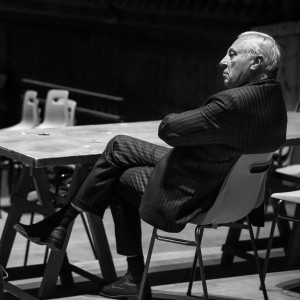A program curated by Flavio Gregori
 The participation of the British visionary artist and film director Peter Greenaway is one of the most anticipated moments of this edition of Ca’ Foscari Short Film Festival. He will be interviewed by Flavio Gregori, Deputy Director for Cultural Activities and Relations and professor of English literature at Ca’ Foscari University of Venice. On this occasion, a series of clips from Greenway’s famous works will be screened, as examples of his expressive force and constant artistic research.
The participation of the British visionary artist and film director Peter Greenaway is one of the most anticipated moments of this edition of Ca’ Foscari Short Film Festival. He will be interviewed by Flavio Gregori, Deputy Director for Cultural Activities and Relations and professor of English literature at Ca’ Foscari University of Venice. On this occasion, a series of clips from Greenway’s famous works will be screened, as examples of his expressive force and constant artistic research.
Painter, film director, writer and videoarstist, Peter Greenaway was born in Newport, Wales, on 5 April 1942. After attending the Forest School in London, he decided to become a painter. He then studied at Walthamstow College of Art and, after approaching the works of Ingmar Bergman, began to dream of becoming a filmmaker. In 1962, Greenaway shot his first short film, Death of Sentiment, and joined the Central Office of Information in 1965, working there for over fifteen years as a film editor and director.
In 1980, he directed his first feature film, The Falls. In the same years, Greenaway’s cinema flowered in his best-known works: The Draughtsman’s Contract (1982), A Zed & Two Noughts (1985), The Belly of an Architect (1987), Drowning by Numbers (1988), winner of the award for Best Artistic Contribution at Cannes Film Festival, and his most controversial film, The Cook, the Thief, His Wife & Her Lover (1989). Among his finest titles also Prospero’s Books (1991), The Baby of Mâcon (1993), The Pillow Book (1996), 8 women and ½ (1999), The Tulse Luper Suitcases (2003-2004), Nightwatching (2007), Goltzius and the Pelican Company (2014) and Eisenstein in Guanajuato (2015). In 2014 he was awarded the BAFTA Prize for his contribution to cinema.
He has also curated works for the opera among other artistic installations, such as his digital exploration of The Wedding at Cana by Paolo Veronese, third in Greenaway’s series Nine Classical Paintings Revisited. The project, exhibited as part of the 2009 Venice Biennale, was defined by The New York Times art writer Roberta Smith as “possibly the best unmanned art history lecture you’ll ever experience.”
